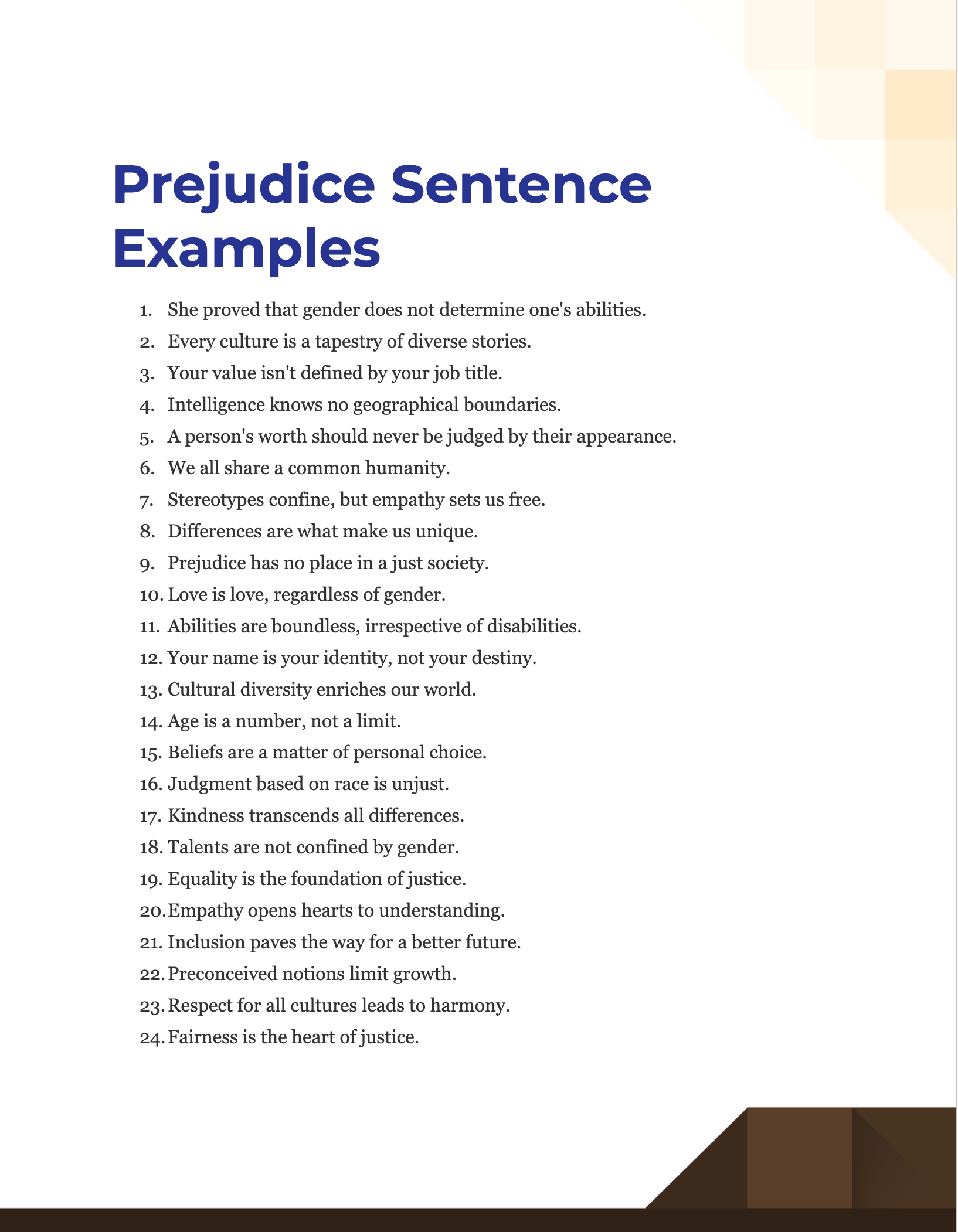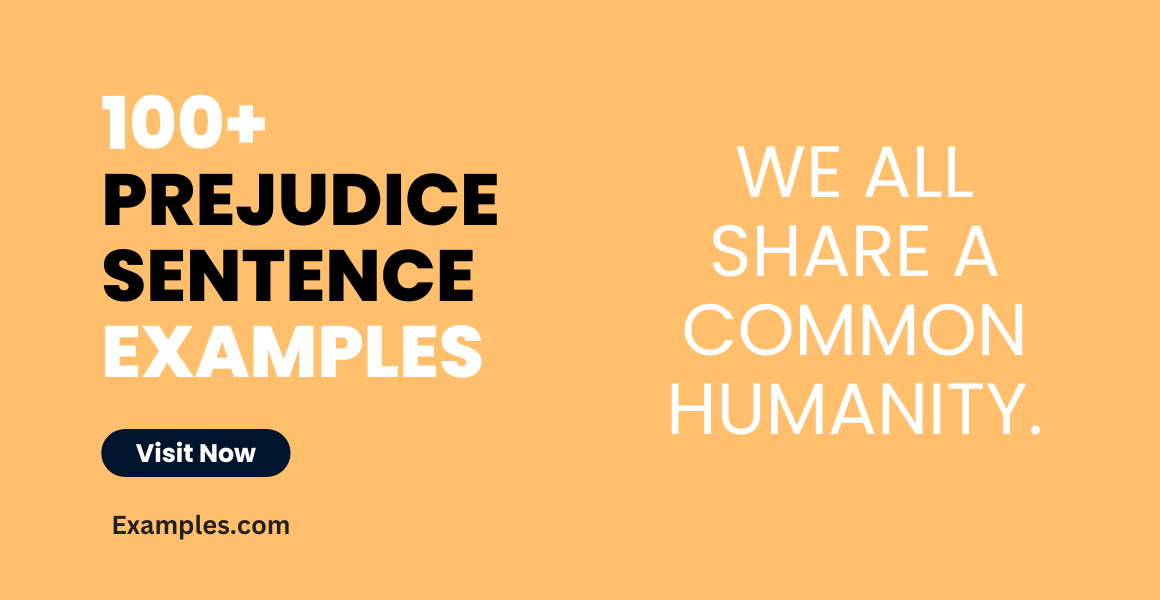99+ Prejudice Sentence Examples
Step into the world of impactful writing with ‘Prejudice Sentence Examples, How to Write, Tips.’ Prejudice sentences wield the power of language to challenge stereotypes, biases, and discrimination. In this comprehensive guide, we explore the art of crafting sentences that illuminate and combat prejudice. We’ll start by providing a clear, simple English definition of a ‘Prejudice Sentence’ and delve into the best example, accompanied by a detailed explanation. Discover how to use your words to promote social change and inclusivity.
What is the Prejudice Sentence? – Definition
A “Prejudice Sentence” is a unique literary construct that employs language to address and challenge preconceived notions, stereotypes, and biases. It serves as a powerful tool to confront discrimination, promote inclusivity, and raise awareness. The structure of a Prejudice Sentence involves the deliberate use of words to challenge societal prejudices. It often highlights disparities, encourages empathy, and fosters social change.
What is the Best Example of a Prejudice Sentence?
Consider the following example: “She proved that gender does not determine one’s abilities.”
In this sentence, the Prejudice Sentence confronts the stereotype that a person’s gender limits their capabilities. By asserting that gender is not a determining factor, it challenges a common prejudice. This example is powerful because it not only defies the stereotype but also encourages a more inclusive and unbiased perspective. Prejudice Sentences like this aim to foster change and create a more equitable society.
100 Prejudice Sentence Usage Examples

Challenge stereotypes, bias, and discrimination with our comprehensive collection of 100 unique Prejudice Sentence examples. These sentences are a powerful tool, designed to encourage empathy and foster social change. Learn how to use language effectively to confront prejudice and promote inclusivity. With a variety of thought-provoking examples, each accompanied by detailed explanations, you’ll gain insight into the art of using words to combat societal biases and create a more equitable world.
- She proved that gender does not determine one’s abilities.
- Every culture is a tapestry of diverse stories.
- Your value isn’t defined by your job title.
- Intelligence knows no geographical boundaries.
- A person’s worth should never be judged by their appearance.
- We all share a common humanity.
- Stereotypes confine, but empathy sets us free.
- Differences are what make us unique.
- Prejudice has no place in a just society.
- Love is love, regardless of gender.
- Abilities are boundless, irrespective of disabilities.
- Your name is your identity, not your destiny.
- Cultural diversity enriches our world.
- Age is a number, not a limit.
- Beliefs are a matter of personal choice.
- Judgment based on race is unjust.
- Kindness transcends all differences.
- Talents are not confined by gender.
- Equality is the foundation of justice.
- Empathy opens hearts to understanding.
- Inclusion paves the way for a better future.
- Preconceived notions limit growth.
- Respect for all cultures leads to harmony.
- Fairness is the heart of justice.
- Every voice deserves to be heard.
- Understanding breaks down walls of prejudice.
- Labels don’t define a person.
- Injustice is everyone’s concern.
- Unity is strength, regardless of background.
- Love knows no boundaries.
- Words can heal or harm; choose wisely.
- Stereotypes confine, but empathy sets us free.
- Each individual is a unique story.
- Empathy bridges divides.
- Equality is a fundamental human right.
- Society thrives when we embrace diversity.
- Fairness knows no prejudice.
- Prejudice is a wall, empathy is a bridge.
- Your potential knows no limits.
- Justice is the foundation of society.
- Understanding conquers ignorance.
- Kindness knows no boundaries.
- Inclusivity is a path to equality.
- Our shared humanity unites us.
- Tolerance fosters peace.
- We all deserve the same opportunities.
- Judging by appearances is superficial.
- Respect for all is the essence of humanity.
- Society progresses through inclusivity.
- Empathy is the antidote to prejudice.
- Bias blinds us to the truth.
- Diversity enriches our lives.
- Equal opportunities are the heart of justice.
- Discrimination is a barrier to progress.
- Empathy opens doors to understanding.
- Injustice harms us all.
- Equality for all is a universal goal.
- Judgment by appearances is a shallow view.
- Respect for diversity is a shared responsibility.
- Stereotypes limit, understanding liberates.
- Our world is enriched by cultural diversity.
- Differences make us stronger.
- Injustice anywhere is a threat to justice everywhere.
- Kindness transcends borders.
- Prejudice divides, empathy unites.
- Judgment should be based on character, not color.
- Equality is a fundamental human right.
- Inclusion fosters unity.
- Respect for all cultures fosters global harmony.
- Empathy is the antidote to hatred.
- Injustice anywhere is a threat to justice everywhere.
- Equality knows no prejudice.
- Diversity is the essence of humanity.
- Prejudice is a chain that binds minds.
- Understanding breaks down walls.
- Inclusivity is the key to unity.
- Empathy erases the lines of division.
- Respect for all is the cornerstone of peace.
- Stereotypes limit, understanding liberates.
- Our world thrives on diversity.
- Bias blinds, but empathy enlightens.
- Equal opportunities are the foundation of progress.
- Discrimination divides, empathy unites.
- Empathy bridges differences.
- Justice is the compass of society.
- Judging based on appearances is shallow.
- Respect for diversity strengthens society.
- Stereotypes isolate, understanding connects.
- Equality is a universal right.
- Inclusion is the roadmap to unity.
- Empathy fosters compassion.
- Injustice harms the collective soul.
- Judgment by appearances is superficial.
- Respect for all is the foundation of harmony.
- Stereotypes constrict, understanding liberates.
- Our world flourishes with cultural diversity.
- Bias blinds, empathy opens eyes.
- Equal opportunities are a human birthright.
- Prejudice imprisons, empathy sets free.
- Unity is our strength.
What is Prejudice Best Examples?
Prejudice, at its core, involves preconceived notions or bias. The best examples of prejudice sentences aim to confront these biases and stereotypes. They often challenge societal norms, biases, or discrimination. A strong prejudice example can be one that sheds light on a particular form of bias and encourages empathy and understanding.
How Do You Use Class Prejudice in a Sentence?
Class prejudice is a specific form of bias related to social and economic status. To use it in a sentence, you can highlight examples that address social or economic discrimination. For example: “Class prejudice often prevents those from lower socioeconomic backgrounds from accessing quality education.”
What is a Sentence with “Without Prejudice”?
A sentence using “without prejudice” typically means that an action or decision is taken without affecting one’s legal or moral rights. For example: “They settled the dispute without prejudice, allowing both parties to maintain their legal rights.”
How Do You Write a Prejudice Sentence? – Step by Step Guide
Creating a Prejudice Sentence is a powerful way to address and challenge bias, stereotypes, and discrimination. Here’s a step-by-step guide on how to craft a Prejudice Sentence:
- Identify the Prejudice: First, identify the type of prejudice or bias you want to address, such as racial, gender, or class prejudice.
- Understand the Bias: Understand the specific stereotypes or biases associated with the prejudice you’ve identified.
- Choose Your Words: Select words that directly confront and challenge the bias while maintaining clarity and empathy.
- Create Impact: Your Prejudice Sentence should aim to create a strong impact, whether it’s through questioning stereotypes, promoting inclusivity, or encouraging empathy.
- Edit and Refine: Review and refine your sentence to ensure it effectively addresses the prejudice without creating confusion or reinforcing the bias.
Tips for Using Prejudice Sentences
- Research the Prejudice: Before crafting a Prejudice Sentence, research the specific prejudice or bias you’re addressing to understand it fully.
- Be Empathetic: Approach your Prejudice Sentence with empathy, aiming to encourage understanding and change rather than blame.
- Use Inclusive Language: Craft your sentence with language that promotes inclusivity and respects diverse perspectives.
- Question Stereotypes: Prejudice Sentences often involve questioning or challenging stereotypes that contribute to the bias.
- Encourage Empathy: Your sentence should inspire empathy and a willingness to see beyond prejudices.
- Promote Social Change: Ultimately, Prejudice Sentences should contribute to promoting social change and a more inclusive society.
- Edit for Clarity: Ensure that your sentence is clear and effectively communicates your message.
- Respect Diverse Experiences: Recognize that individuals may have different experiences related to the prejudice you’re addressing.
By following this guide and applying these tips, you can create Prejudice Sentences that are powerful tools for challenging bias, promoting inclusivity, and encouraging social change.



